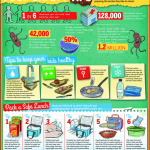
The bagged lunch looks much different today than it once did. Most of us felt limited to carrying the traditional sandwich, chips and drink because of safety reasons. Although this is a good option, when repeatedly eaten, it gets pretty boring! There are many different lunch options including leftovers of a favorite main dish that be safely enjoyed a day or two later as a packed lunch for school or work.
Whether it is a student taking lunch to school or an adult packing lunch for work, millions will take “bag” lunches with them each day and will want to make sure their food is safe to eat.Here are a couple of tips on how you can safely pack you and your child’s lunch.
- Keep Foods Clean: Keep everything clean when packing the lunch. That not only goes for the food, but also food preparation surfaces, hands and utensils. Use hot, soapy water. Keep family pets away from kitchen counters. Wash your hands before you prepare or eat food.
- Keep Foods Out of Danger Zone: Bacteria grow and multiply rapidly in the danger zone between 40 ºF and 140ºF for more than 2 hours (1 hour when the temperature is above 90 F). At room temperature, just ONE bacterium could grow to 2,097,152 bacteria in 7 hours. Keep lunches out of direct sunlight and away from radiators or other heat sources. Some foods that don’t require refrigeration and are great to include in a bag lunch are fruits, vegetables, hard cheese, unopened canned meat or fish, chips, bread, crackers, peanut butter, jelly, mustard and pickles.
- Keep Cold Foods Cold: The best way to keep food cold is with an insulated box. When packing lunches, include either freezer gel packs or cold food items such as small frozen juice packs. Nestle perishable meat, poultry or egg sandwiches between these cold items. Sandwiches can also be made ahead of time and kept refrigerated or frozen before placing in the lunch box. Freezer gel packs will hold cold food until lunchtime, but generally will not work for all-day storage. Any perishable leftovers after lunch should be discarded and not brought home. Of course, if there’s a refrigerator at work, store perishable items there upon arrival. Leftover perishables that have been kept refrigerated should be safe to take home. Brown paper bags or plastic lunch bags can also be used to store foods if you are not carrying perishable foods, but they do not work as well for cold foods. The bag tends to become soggy or leak as cold foods thaw, and the bags do not retain the cold as well as an insulated lunch box. If a freezer gel pack is being used in the paper bag, it will cause additional moisture as it melts. Wrap the freezer pack in plastic or foil and use an extra paper bag to create a double layer to help solve the problem.
- Keep Hot Foods Hot: Foods like soup, chili and stew need to stay hot. Use an insulated bottle stored in an insulated lunch box. Fill the bottle with boiling water, let stand for a few minutes, empty and then put in the piping hot food. Keep the insulated bottle closed until lunch to keep the foods hot. Byfollowing these safety tips, you can avoid foodborne illnesses when eating from a lunch box or bag lunch.
Sources: http://www.clemson.edu/extension/hgic/food/pdf/hgic3600.pdf and http://food.unl.edu/packed-lunch-safety
Stephanie